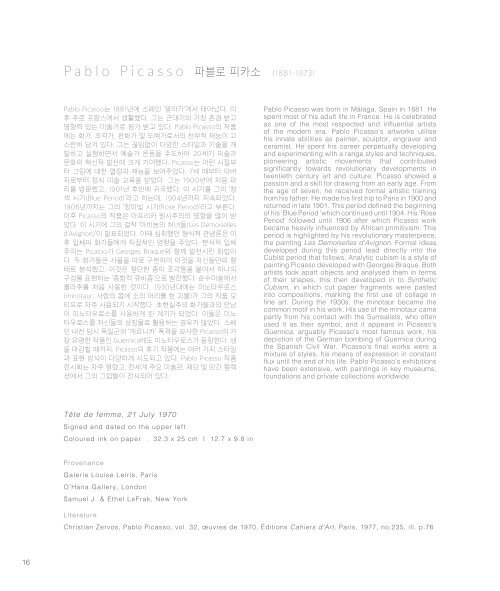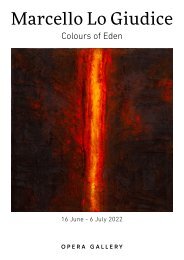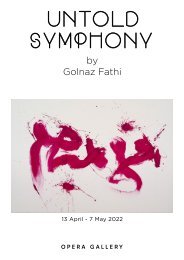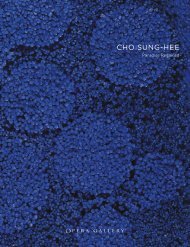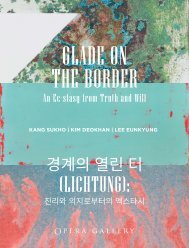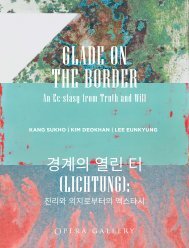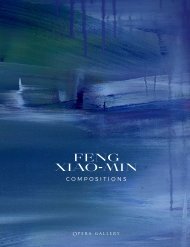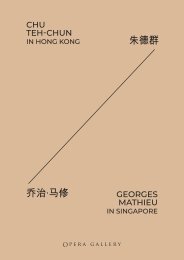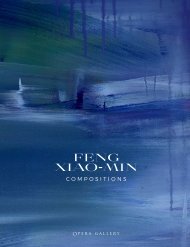Seoul Re-Opening
Catalogue for the Seoul Re-Opening Exhibition
Catalogue for the Seoul Re-Opening Exhibition
You also want an ePaper? Increase the reach of your titles
YUMPU automatically turns print PDFs into web optimized ePapers that Google loves.
Pablo Picasso 파블로 피카소 (1881-1973)<br />
Pablo Picasso는 1881년에 스페인 ‘말라가’에서 태어났다. 이<br />
후 주로 프랑스에서 생활했다. 그는 근대기의 가장 존경 받고<br />
영향력 있는 미술가로 평가 받고 있다. Pablo Picasso의 작품<br />
에는 화가, 조각가, 판화가 및 도예가로서의 천부적 재능이 고<br />
스란히 담겨 있다. 그는 끊임없이 다양한 스타일과 기술을 개<br />
발하고 실험하면서 예술가 운동을 주도하여 20세기 미술과<br />
문화의 혁신적 발전에 크게 기여했다. Picasso는 어린 시절부<br />
터 그림에 대한 열정과 재능을 보여주었다. 7세 때부터 아버<br />
지로부터 정식 미술 교육을 받았다. 그는 1900년에 처음 파<br />
리를 방문했고, 1901년 후반에 귀국했다. 이 시기를 그의 ‘청<br />
색 시기(Blue Period)’라고 하는데, 1904년까지 지속되었다.<br />
1906년까지는 그의 ‘장미빛 시기(Rose Period)’라고 부른다.<br />
이후 Picasso의 작품은 아프리카 원시주의의 영향을 많이 받<br />
았다. 이 시기에 그의 걸작 ‘아비뇽의 처녀들(Les Demoiselles<br />
d'Avignon)’이 발표되었다. 이때 심취했던 형식적 관념론은 이<br />
후 입체파 화가들에게 직접적인 영향을 주었다. 분석적 입체<br />
주의는 Picasso가 Georges Braque와 함께 발전시킨 화법이<br />
다. 두 화가들은 사물을 따로 구분하여 이것을 자신들만의 형<br />
태로 분석했고, 이것은 절단한 종이 조각들을 붙여서 하나의<br />
구성을 표현하는 ‘종합적 큐비즘’으로 발전했다. 순수미술에서<br />
콜라주를 처음 사용한 것이다. 1930년대에는 미노타우로스<br />
(minotaur; 사람의 몸에 소의 머리를 한 괴물)가 그의 작품 모<br />
티프로 자주 사용되기 시작했다. 초현실주의 화가들과의 만남<br />
이 미노타우로스를 사용하게 된 계기가 되었다. 이들은 미노<br />
타우로스를 자신들의 상징물로 활용하는 경우가 많았다. 스페<br />
인 내전 당시 독일군의 ‘게르니카’ 폭격을 묘사한 Picasso의 가<br />
장 유명한 작품인 Guernica에도 미노타우로스가 등장한다. 생<br />
을 마감할 때까지, Picasso의 후기 작품에는 여러 가지 스타일<br />
과 표현 방식이 다양하게 시도되고 있다. Pablo Picasso 작품<br />
전시회는 자주 열렸고, 전세계 주요 미술관, 재단 및 민간 컬렉<br />
션에서 그의 그림들이 전시되어 있다.<br />
Pablo Picasso was born in Málaga, Spain in 1881. He<br />
spent most of his adult life in France. He is celebrated<br />
as one of the most respected and influential artists<br />
of the modern era. Pablo Picasso's artworks utilise<br />
his innate abilities as painter, sculptor, engraver and<br />
ceramist. He spent his career perpetually developing<br />
and experimenting with a range styles and techniques,<br />
pioneering artistic movements that contributed<br />
significantly towards revolutionary developments in<br />
twentieth century art and culture. Picasso showed a<br />
passion and a skill for drawing from an early age. From<br />
the age of seven, he received formal artistic training<br />
from his father. He made his first trip to Paris in 1900 and<br />
returned in late 1901. This period defined the beginning<br />
of his 'Blue Period 'which continued until 1904. His ‘Rose<br />
Period’ followed until 1906 after which Picasso work<br />
became heavily influenced by African primitivism. This<br />
period is highlighted by his revolutionary masterpiece,<br />
the painting Les Demoiselles d'Avignon. Formal ideas<br />
developed during this period lead directly into the<br />
Cubist period that follows. Analytic cubism is a style of<br />
painting Picasso developed with Georges Braque. Both<br />
artists took apart objects and analysed them in terms<br />
of their shapes, this then developed in to Synthetic<br />
Cubism, in which cut paper fragments were pasted<br />
into compositions, marking the first use of collage in<br />
fine art. During the 1930s, the minotaur became the<br />
common motif in his work. His use of the minotaur came<br />
partly from his contact with the Surrealists, who often<br />
used it as their symbol, and it appears in Picasso's<br />
Guernica, arguably Picasso's most famous work, his<br />
depiction of the German bombing of Guernica during<br />
the Spanish Civil War. Picasso's final works were a<br />
mixture of styles, his means of expression in constant<br />
flux until the end of his life. Pablo Picasso's exhibitions<br />
have been extensive, with paintings in key museums,<br />
foundations and private collections worldwide.<br />
Tête de femme, 21 July 1970<br />
Signed and dated on the upper left<br />
Coloured ink on paper . 32.3 x 25 cm I 12.7 x 9.8 in<br />
Provenance<br />
Galerie Louise Leiris, Paris<br />
O’Hana Gallery, London<br />
Samuel J. & Ethel LeFrak, New York<br />
Literature<br />
Christian Zervos, Pablo Picasso, vol. 32, œuvres de 1970, Éditions Cahiers d’Art, Paris, 1977, no.235, ill. p.76<br />
16


